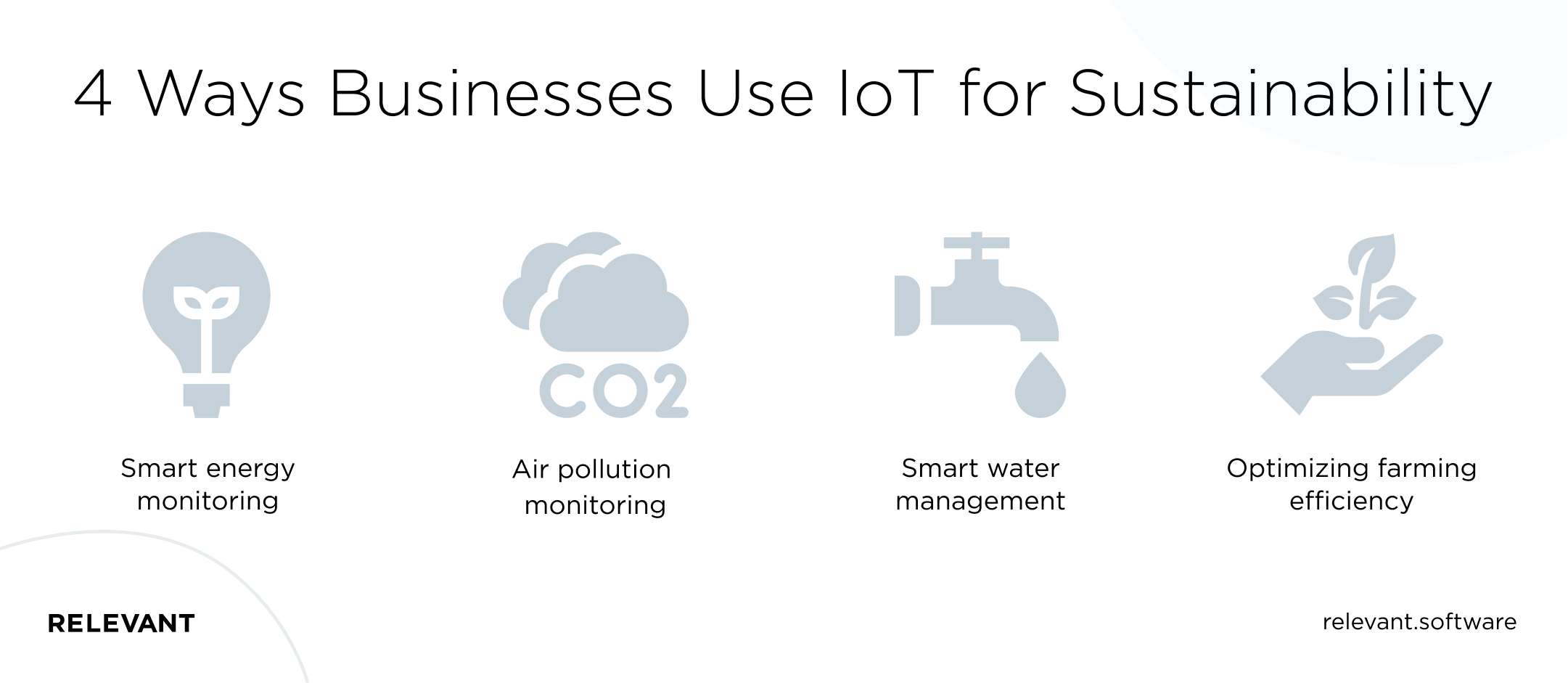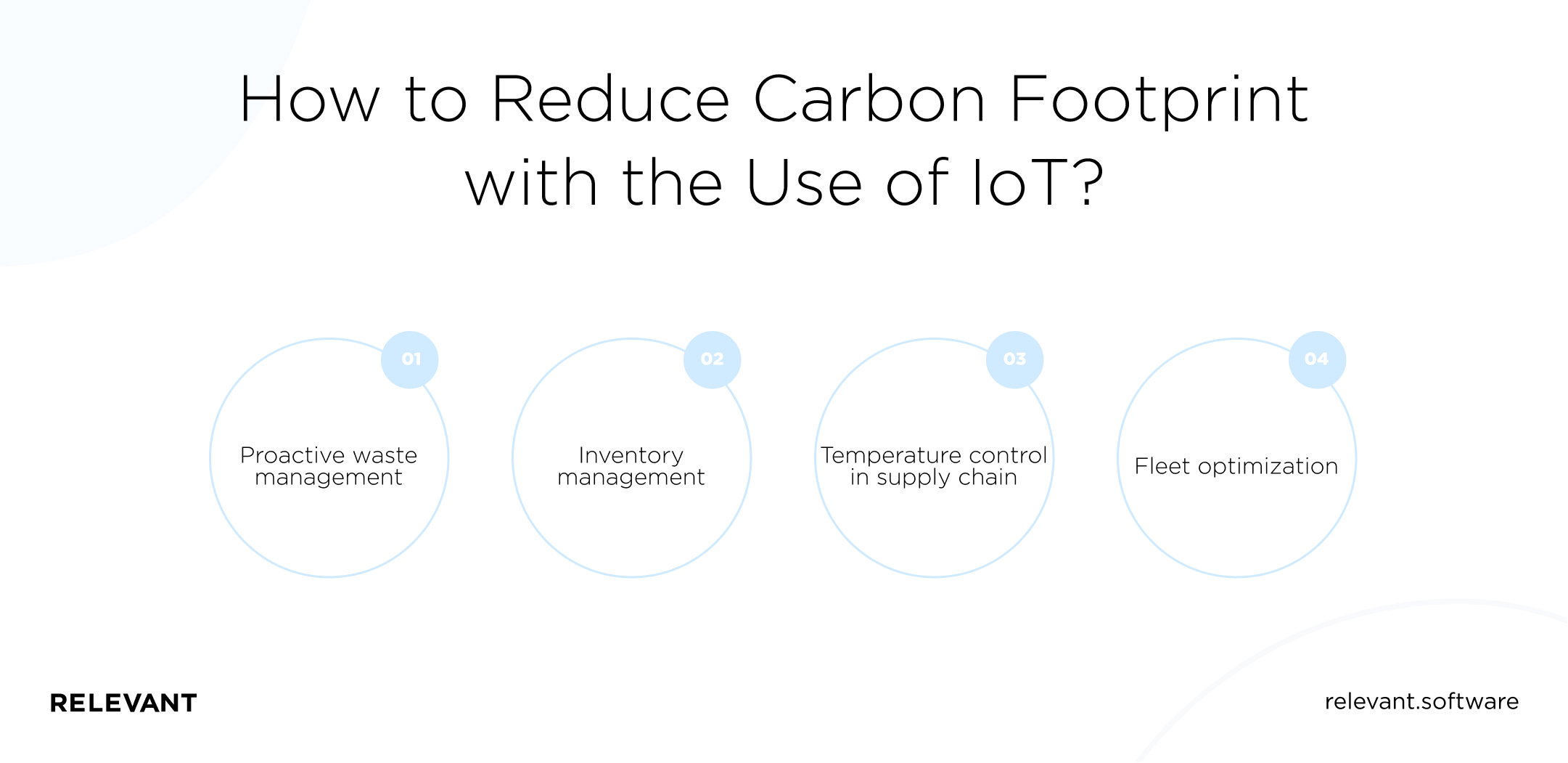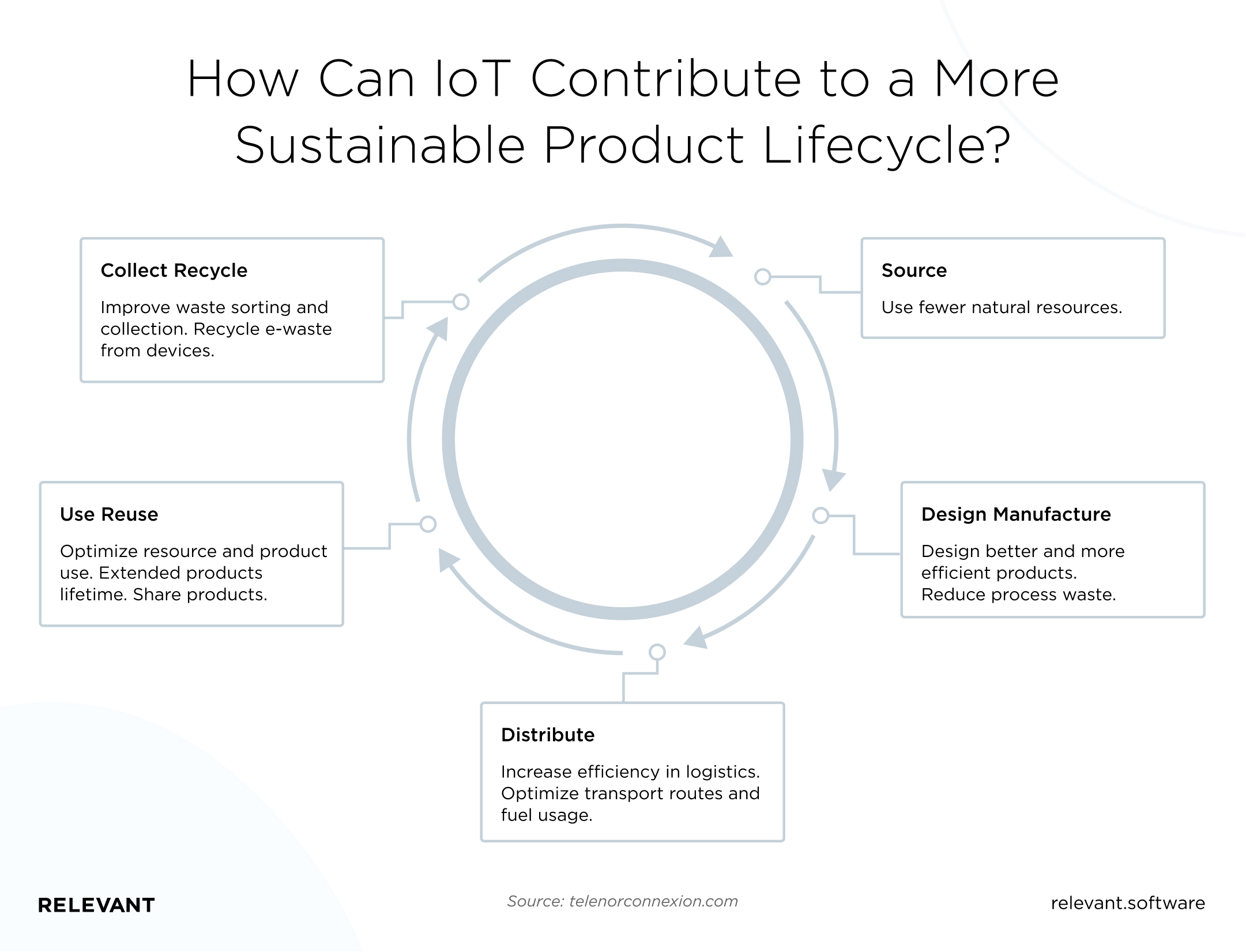IoT and Sustainability: How Business Can Improve Environmental Footprint with the Internet of Things
Updated: August 16, 2024
As climate change worsens, sustainability has become less of a buzzword and more of a reality. At the front line of this environmental effect are greenhouse gas (GHG) emissions. According to the Environmental Protection Agency, fossil fuels and industrial processes generate 65% of global carbon emissions. This gas is the largest driver of global warming.

With these emissions and the continuous use of natural resources, companies’ environmental footprints have widened, potentially damaging the planet. Fortunately, IoT solutions have opened up efficient ways organizations can reduce their footprint.

We provide companies with senior tech talent and product development expertise to build world-class software. Let's talk about how we can help you.
Contact usIn this article, we’ll explain how IoT can help build an eco-friendly business and a sustainable product life cycle to improve the environmental footprint of organizations.
Table of Contents
What is an environmental footprint?
Environmental footprint quantifies the impact of a product, service, or company on the environment throughout its life cycle. It enables individuals and entities to assess the sustainability of a lifestyle and how best to allocate resources.
Some common footprints include water, carbon, and nitrogen. We can determine environmental footprints at any scale, whether for a city, person, corporation, activity, country, or humanity. Here, we’ll focus on the corporate level.
How does IoT help build an innovative, environmentally friendly business?
The Internet of Things is one of the key drivers of digital transformation. It helps organizations to collect and analyze data to uncover insights and streamline operations. But how can IoT help the environment? More so, how can businesses harness IoT for sustainability? How can we use IoT for climate change?

Smart energy monitoring
Energy production and consumption affect the environment. For one, burning fossil fuels to generate electricity and heat releases greenhouse gases. Although there is not much data on just how much energy businesses consume, some usage areas are pretty substantial. For example, HVACs in commercial buildings take up over 40 percent of their total energy use. Luckily, in this case, IoT has opened up ways to optimize energy usage.
Smart plugs, voice-activated AC controllers, smart thermostats, and other IoT-enabled devices help to reduce energy consumption. Let’s look at IoT office solutions. IoT environmental monitoring sensors can automatically detect room occupancy and adjust lighting, cooling, and heating systems to save energy. These devices can make adjustments based on occupancy data, schedules set by an operator, or environmental conditions.
Also, using sub-metering in facilities allows businesses to monitor consumption costs by sections and identify areas for improvement. Through wireless connectivity and sensors, organizations can track real-time operational data, monitor consumption, and forecast demand to take proactive steps towards sustainability.
Air pollution monitoring
Air pollution comes from various sources. However, specific sectors are at the forefront of industrial emissions. According to Climate Watch, the energy and agricultural industry contributes to 76% and 12% of global Greenhouse Gas (GSG) emissions, respectively.
Other sectors also contribute to air pollution through employee commutes, operational activities, and business trips. Therefore, building a sustainable business is a collective responsibility.
IoT-based environmental monitoring systems can combat these issues by providing real-time air quality data to identify and address pollution concerns. For example, scientists recently used IoT sensors to detect methane leaks in several energy infrastructures, including remote areas. These solutions can help businesses monitor facility-wide emissions and take preventive or mitigative measures to reduce their environmental footprint.
Water management
As the global population grows, so does the demand for water resources. The World Bank estimates that 40% of the world population lives in water-scarce regions. By 2025, 1.8 billion people will live in an absolute scarcity of this resource. Researchers expect even more damaging effects on lives and the environment with predictions of frequent, uncertain floods and droughts fueled by climate change.
For businesses—especially water-intensive industries—this could mean higher water costs, disruptions, or a complete halt in operations. Using IoT big data solutions, companies can track water pressure, temperature to detect leakages, optimize water treatment processes, and minimize wastage.
Optimizing farming efficiency
The Food and Agriculture Organization of the UN estimates that food production will need to increase by 60% to feed 10 billion people by 2025. Intensive farming may seem like a solution to this problem but is not as it contributes to over one-quarter of the global greenhouse gases emissions. Therefore, adopting sustainable practices will enable relevant businesses to meet the food demands without increasing their footprint.
A cloud-based temperature monitoring system using IoT makes it easier to monitor and access humidity, temperature, and the weather across connected devices. With this data, farmers can adjust environmental conditions within controlled spaces to ensure year-round crop production and higher yields.
Also, smart sensors enable real-time monitoring of irrigation systems, soil quality, livestock health, and crop conditions to ensure efficient use of resources. For example, by installing smart traps, farmers can detect pest infestation and determine where and how to administer pesticides, minimizing the use of chemicals to reduce emissions.
Read more on energy sector software development
What about the carbon footprint?
Carbon footprint is the fastest-growing part of the environmental footprint. Currently, it represents 60% of the ecological footprint of human activities, making it more significant than any other. To reduce your company’s impact on the environment, the first step is to know how to calculate your CO2 footprint.

How to measure the carbon footprint
There are a few ways to measure carbon footprint at organizational levels, but two common approaches are the Life-cycle Assessment (LCA) and Greenhouse Gas methods.
- Life-cycle assessment (LCA)
This multi-criterion approach measures the overall environmental impact of an activity or organization based on a life cycle approach. It considers GHG emissions, depletion of natural resources, human health, and other critical direct and indirect factors that affect the environment. The core international standards for conducting LCAs are ISO 14040 and ISO 14044. - Greenhouse gas protocol
GHG protocol is the most widely used accounting framework for measuring and controlling Greenhouse Gas emissions of an organization. It is evaluated across three scopes.
Scope 1 measures direct emissions from sources a company owns or controls. Examples are company vehicles and on-site fuel combustion.
Scope 2 includes indirect emissions from the generation of energy an organization consumes.
The 3rd scope covers other indirect emissions outside a company’s operations that may affect its value chain. Examples are workers’ commutes, waste disposal, purchased goods, and services, etc. Each scope has detailed requirements and information for a reliable measurement.
Manually tracking the carbon footprint of a company can be tasking. Specific and cross-sector calculators and tools can provide businesses with an in-depth analysis of their footprints. There are also CO2 trackers for a quick assessment.
How to reduce your carbon footprint with IoT technology
Besides the internet of things environmental sustainability solutions we mentioned earlier, this technology can help businesses reduce carbon emissions through:

- Proactive waste management
According to the World Bank, solid waste will increase by 70% by 2025. As a scope 3 source of emissions, minimizing waste could boost a company’s chance of reducing its carbon footprint. IoT technologies like Electronic Shelf Labels can help companies save on paper and plastics, which end up in landfills. Also, through wireless sensors, operators can monitor fill levels and microbial activities in waste containers to schedule the best disposal time. - Inventory management
Excess stock will often result in product spoilage and waste that harms the environment. Advances in IoT mitigate these problems by providing real-time data on optimal inventory levels. For example, drones enable accurate stock measurement, especially in hazardous or harder-to-reach areas. - Temperature control in supply chain
Smart environment monitoring systems can help businesses monitor and remotely control room temperature, humidity, light, etc., for sensitive goods. This translates to fewer wastages and lower transportation needs and emissions. - Fleet optimization
The transportation industry, particularly, has a large carbon footprint. With the sector’s C02 emissions estimated to increase up to 60% by 2050, it is essential to take counteractive measures. Using IoT sensors, operators can monitor driver behavior, idling, and driving conditions. Having this information will enable companies to optimize routes, perform predictive maintenance, and lower fuel usage to reduce carbon emissions.
How IoT technology helps to build a sustainable product lifecycle
The traditional approach towards sustainability primarily focuses on a company’s internal processes and how it creates products. However, the environmental impact of this take-make-dispose model is not favorable. Instead, it is essential to adopt an approach that seeks to minimize natural resources from creation to recycling of products.
Here we’ll look at the sustainable product life cycle and how IoT environmental impact extends to each stage.
Sourcing
Certain agricultural practices such as growing, harvesting, and processing result in waste of resources. And IoT can help solve this problem. Farming is actually one of the most known applications of IoT in agriculture. Farmers can use IoT and environmental sensors to collect data to; detect leakages, optimize irrigation systems, and identify when, where, and how to apply fertilizers and fumigants. These sustainable practices not only benefit the environment but also influence stakeholders’ decisions. For example, companies and investors can use ESG software to make investment decisions based on the environmental, social, and governance impact of specific organizations.
Manufacturing and design
In this stage, IoT deployment can help businesses in two ways: optimizing production processes and decreasing waste. Sensors monitor and provide precise, real-time data to reduce quality incidents, energy consumption, downtime maintenance, and process waste. Using IoT data, manufacturers can gain insight into parts or components that require improvements in subsequent versions after prototype testing.
Distribution
Up to one-third of the food produced globally is wasted. These wastages are common along the production and supply chains. By harnessing IoT data, fleet operators can optimize routes and track driving conditions to speed up delivery while reducing carbon emissions. In addition, environmental monitoring systems using IoT can help supply chains monitor ambient conditions and alert them when sensitive products are overly exposed to air, heat, cold, etc.
Product usage
The most common area where IoT helps to optimize consumption is energy. Smart buildings using IoT-enabled devices can adjust lighting, heating, and cooling systems based on occupants’ behavior. This cuts down carbon dioxide emissions by reducing the burning of fossil fuels for energy. Relevant provides a range of software product development services, particularly the development of environmental trackers, tailored to your business needs.
Waste collection and recycling
Less than 20% of e-waste is recycled, leaving 80% on landfills. Reducing and recycling these wastes will enable companies to cut down their environmental footprint. Implementing IoT solutions enhance waste sorting for degradable and non-degradable materials. Sensors in smart bins can then track container capacity and alert operators to pickup times.
Also, advances in IoT have progressed the as-a-service model by improving connectivity through data. This model has shifted product ownership from consumers to service providers, giving businesses the responsibility of disposing and recycling components.

How can Relevant help you with your IoT Development projects?
Relevant has profound expertise in building IoT software, especially ecological footprint trackers for companies. We have helped businesses develop trackers to monitor CO2 emissions, air quality, and more.
These trackers, for example, the carbon footprint calculator, can help companies monitor how their activities contribute to GHG emissions. Depending on the specifications, this solution may also alert users to possible carbon pollutants.
In addition to carbon footprint calculator development, other services we provide include:
- Web development
- Mobile app development
- Cybersecurity
- Quality assurance
- Dedicated development team
- UI/UX design
- Product development
Read more on fact-backed reasons to consider Ukraine outsourcing.
Relevant Case Study 1: Bringing outdoor sensor data to users
Our client, Sensor Innovation, came to us with an existing system. The software combines smart sensors and cloud technology to monitor the moisture in buildings. However, it needed an intuitive UI and more functionality.
What we did: We assembled a team of 4 developers, a UI/UX designer, and a product manager. Our team implemented additional features such as a customizable building map, user roles, and a weather dashboard to improve real-time monitoring and alerts.
Outcome: The features we added decreased the frequency of false alarms, improved the user interface, and optimized coverage in the Sensor Innovation system.
Relevant Case Study 2: Visualizing air quality sensor data in a web dashboard
Airthings is a Norwegian tech company that manufactures indoor radon monitoring products. The challenge was to improve real-time data tracking and visualization from connected Airthings devices.
What we did: Our engineers delivered additional functionality like monitoring and alert systems, dashboard customization, CSV export, and device tiles.
Outcome: With the features we implemented, Airthings can now monitor its devices around the world without lags. Also, customers can track their indoor air quality.
Summary
With the increasing climate change coupled with more emphasis on eco-friendly practices, sustainability is not optional. It is a necessity. Businesses will need to rethink how they create, distribute, dispose and redeploy products. Harnessing IoT for sustainable development projects will open up the potential of efficiently managing these processes while reducing your ecological footprint.
If you need to hire IoT Developer or an IoT software development company to help you build sustainable solutions, Relevant is here. Our team of developers is experienced in building IoT software to track your carbon emissions and other environmental conditions. Contact us today to get started.
FAQs
Our core services:
Do you want a price estimate for your project?
Do you know that we helped 200+ companies build web/mobile apps and scale dev teams?
Let's talk about your engineering needs.
Write to us











